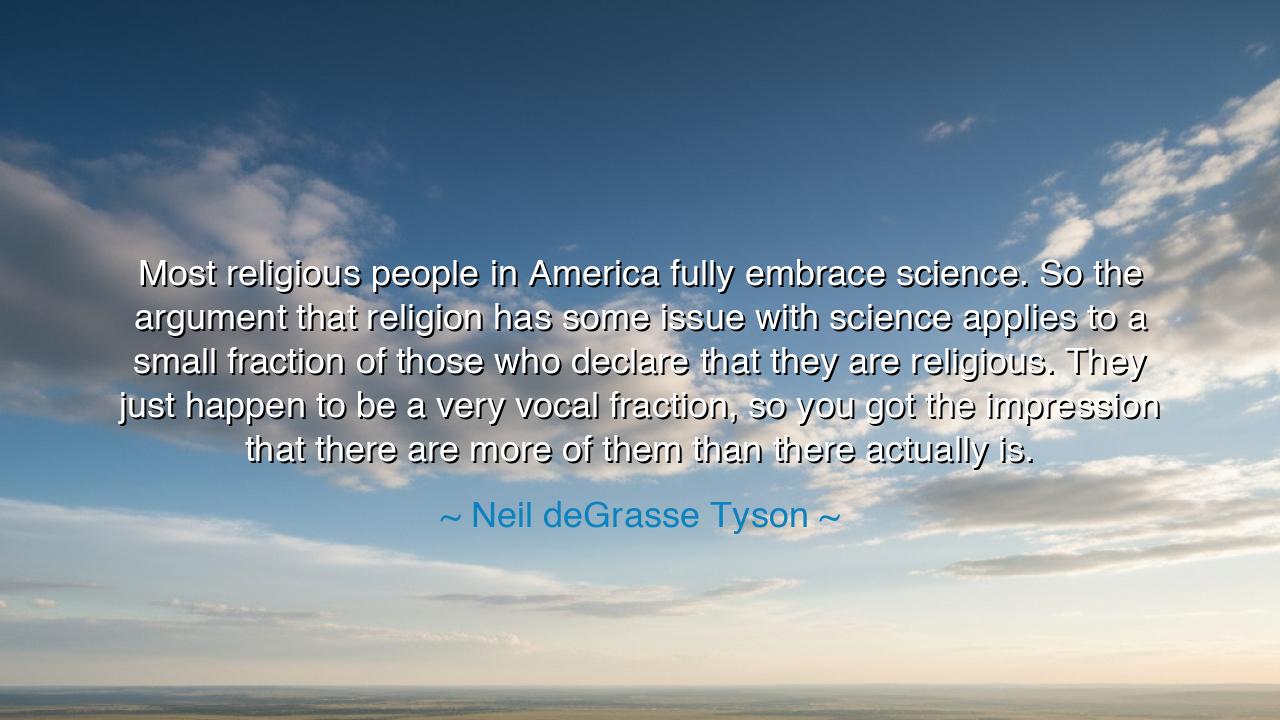
Most religious people in America fully embrace science. So the
Most religious people in America fully embrace science. So the argument that religion has some issue with science applies to a small fraction of those who declare that they are religious. They just happen to be a very vocal fraction, so you got the impression that there are more of them than there actually is.






Hear, O seekers of knowledge and harmony, the words of Neil deGrasse Tyson, who declared: “Most religious people in America fully embrace science. So the argument that religion has some issue with science applies to a small fraction of those who declare that they are religious. They just happen to be a very vocal fraction, so you got the impression that there are more of them than there actually is.” In these words is both comfort and correction: that the supposed war between faith and reason is not the true story of humanity, but the shouting of a few who mistake their loudness for the voice of the many.
The origin of this saying lies in Tyson’s mission as a scientist and communicator, one who has sought to bring the wonders of the cosmos to the public. Living in an age where debates rage between believers and skeptics, he has observed that most men and women of faith do not deny the truths of science, but welcome them as a way of understanding creation. It is only a small group—loud, insistent, and unyielding—that has shaped the impression of a deep rift. Tyson, with clarity, tears away the illusion: the conflict is not universal, but the voice of the minority magnified.
Consider the meaning. The stars do not dim for the believer, nor does gravity cease to act because of prayer. The laws of nature remain constant, and many of the faithful have long embraced them. Indeed, the history of science itself is filled with men and women of faith: Copernicus, Kepler, Mendel, and countless others who studied the heavens and the earth with reverence. The idea that religion and science must be enemies is a distortion, born of those who raise their voices in denial, while the quiet multitude continues to hold both microscope and scripture in the same hand.
History gives us shining examples. Gregor Mendel, the father of genetics, was an Augustinian friar whose devotion to both God and science gave us the first principles of heredity. Georges Lemaître, a Catholic priest, first proposed the Big Bang theory, the very idea that the universe had a beginning. These men did not see conflict between their faith and science, but harmony. Their work testifies that one can kneel in prayer and still rise to explore the mysteries of atoms and galaxies. The loud deniers were always fewer than the faithful seekers of truth.
Yet, Tyson warns us of the danger of the vocal fraction. Throughout history, it has often been the few, not the many, who have dominated the stage. A handful of voices declaring enmity between religion and science can drown out the millions who embrace both. Just as in politics or war, the extremists draw the eye, while the quiet builders of bridges remain unseen. To judge by noise alone is to mistake the fringe for the foundation, the echo for the chorus.
The meaning for our time is urgent: do not believe the illusion of division where unity exists. The harmony between faith and science is vast, but hidden beneath the noise of conflict. Recognize that most people—believers and non-believers alike—seek truth, seek understanding, seek wonder. The stars shine for all, and the laws of nature are not bound to creed. Only by refusing to be deceived by the loud minority can we see the quiet truth: that science and faith need not destroy each other, but may together illuminate the human spirit.
The lesson, then, is clear. Listen carefully, and do not mistake the noise of the few for the voice of the many. Seek harmony, for the world grows stronger when science and faith walk side by side. Honor truth, whether it comes from telescope or temple, for both may guide us closer to wisdom. And above all, do not fear dialogue, for honest exchange reveals that the division is smaller than it seems, and that cooperation is greater than conflict.
Thus let the words of Neil deGrasse Tyson endure: “Most religious people in America fully embrace science… the loud are few, but they seem many.” Take comfort in this truth, and let it embolden you to rise above division, to celebrate both the wonder of discovery and the power of belief, and to live as one who sees not opposition, but unity, in the pursuit of understanding.






AAdministratorAdministrator
Welcome, honored guests. Please leave a comment, we will respond soon